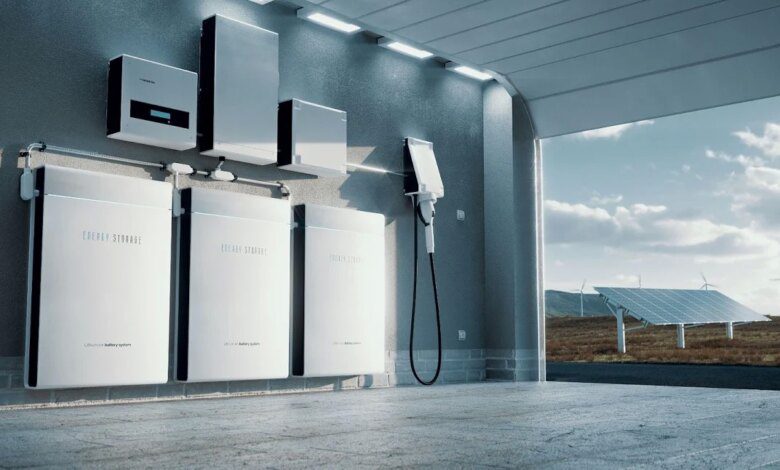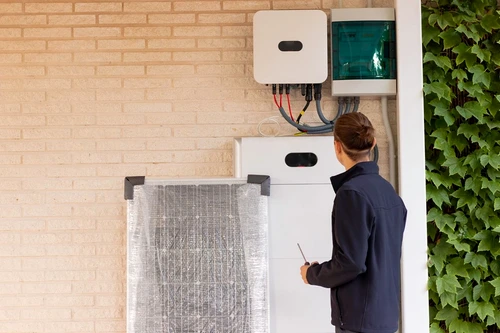
How to choose the right battery for a photovoltaic panel: buying guide
Photovoltaic panels are an excellent source of renewable and clean energy, and solar panels are a critical element for storing this energy.
If you're looking to install a solar system at home or business, it's important to know how to choose the right battery for your panel.
When choosing a solar battery, there are several factors to consider such as capacity, efficiency, durability, and cost. You also need to consider the specific requirements of your solar system and your energy consumption needs.
This buying guide will give you an overview of what to consider when choosing the right battery for your photovoltaic panel. You'll learn about the types of solar panels available, how to calculate the power required, and how to compare prices and features of different battery models.
The content of the article
- 1 How does a battery work for your photovoltaic panel?
- 2 What types of batteries are there and which one is best for you?
- 3 How to calculate battery capacity for photovoltaic panel:
- 4 Battery selection criteria for photovoltaic panels:
- 5 How to Maintain the Battery for Your Photovoltaic Panel
- 6 Top 5 batteries suitable for photovoltaic panels:
How does a battery work for your photovoltaic panel?
The battery is a vital component of a photovoltaic system as it stores the electricity generated by the solar panel for later use. A battery can be compared to a water tank in the sense that it stores the excess electricity produced by the solar panel, which it releases when the panel is not producing enough electricity. Typically, photovoltaic panel batteries operate through a chemical conversion process in which electrical energy is stored in chemical form and released when needed.
What types of batteries are there and which one is best for you?
There are several types of batteries for photovoltaic systems, the most common being lead-acid and lithium-ion batteries. Lead-acid batteries are cheaper and more reliable, but have a shorter lifespan than lithium-ion batteries, which are more expensive and less reliable, but have a longer life. There are other types of batteries available, such as nickel-cadmium and salt batteries, but they are not as popular as lead-acid and lithium-ion.
To select the right battery for your PV system, you need to consider your specific needs. For example, if you need a battery with a longer life, lithium-ion is a better option than lead-acid. If, on the other hand, cost is a major concern, a lead-acid battery may be your best choice.
How to calculate battery capacity for photovoltaic panel:
The battery capacity of a photovoltaic panel is a measure of the amount of energy it can store and can be calculated depending on your needs and the system used. Its power is usually measured in ampere hours (Ah) or kilowatt hours (kWh).
To calculate the required battery capacity, it is necessary to take into account the daily consumption and the amount of energy that the photovoltaic system can produce during the day. In general, your daily energy consumption can be estimated by adding up the consumption of each device you use during the day, and the daily output of a photovoltaic system can be estimated by multiplying the panel output by the number of hours of sunlight available during the day. day.
Battery selection criteria for photovoltaic panels:
Before purchasing a battery for a photovoltaic panel, it is important to consider a number of important battery selection criteria. These include:
- life expectancy;
- Expenses;
- loading and unloading times;
- operating temperature and others.
Battery life is important to ensure good PV system performance in the long term. The cost depends on the type, capacity and service life. Battery charging and discharging times may vary, and these characteristics may be important to ensure consistent and stable power supply. Operating temperature may affect performance, and higher temperatures may shorten life.
Recommendations for choosing the best battery:
To choose the best battery for your solar panel, you'll need to consider your specific criteria, such as energy needs, budget, and personal preferences. One option is to consult with a solar energy specialist who can help you choose the battery that best suits your needs.
Batteries with longer lifespans tend to be more expensive, but can be more economical in the long run since they need to be replaced less frequently. Charging and discharging times can be important, especially if you need a constant and stable power source. Battery operating temperature is also important to ensure optimal performance.
How to Maintain the Battery for Your Photovoltaic Panel
Battery maintenance for your solar panel is essential to ensure optimal system performance. Here are some tips to keep your battery in the best condition:
- Checking the water level. Some batteries require water to function properly, so check the water level regularly and add distilled water if necessary.
- Cleaning the Terminals: Dirt and oxidation can cause loss of power and affect battery performance. To avoid this, clean the terminals with a brush and a solution of baking soda and water.
- Checking the voltage: Check the voltage regularly to make sure it is within the normal range. If the voltage is too low, it means the battery is not charging enough and needs to be recharged.
- Maintaining optimal temperature. Excessively high or low temperatures can affect battery performance, so be sure to keep your battery at the optimal temperature to avoid damage.
Top 5 batteries suitable for photovoltaic panels:
- Lithium-ion batteries: These are the most popular batteries used in photovoltaic systems due to their high energy storage capacity, long lifespan, and ability to be charged and discharged repeatedly without loss of performance.
- Lead acid batteries: These batteries are cheaper than lithium-ion and have a shorter lifespan, but are suitable for small systems or backup power.
- Flow batteries: They have a long service life and are highly resistant to overloads and overdischarges. However, they are more expensive than other types of batteries and require a special charge controller.
- Salt batteries: These batteries are a new and more innovative option that uses liquid salt to store energy. They are very reliable and have a long lifespan, but are more expensive than other types of batteries.
- AGM batteries (absorbent glass mat): These batteries are very vibration resistant and can be installed in any position. They are more expensive than lead-acid batteries, but have a longer life and require less maintenance.
When choosing a battery for a photovoltaic system, it is important to consider criteria such as service life, capacity, cost, and charging and discharging times. Lithium-ion batteries are usually the best choice due to their high performance and long life, but if budget is an issue, lead-acid batteries are a more affordable option.
If you need a battery that has a long life and is resistant to overcharging and over-discharging, then flux or salt batteries may be a good option, but you also have to consider the higher costs. AGM batteries are a good option for smaller systems or power backups because they require less maintenance and are more resistant to vibration.
Before purchasing a battery for your PV system, make sure you understand your specific needs and requirements so you can make an informed decision. It would also be a good idea to consult with a solar expert or look for opinions and reviews online to make sure your choice best suits your needs.
















